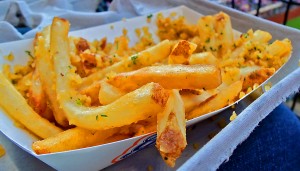 South or Market or South of the Slot as it used to be known is an interesting part of San Francisco historically. It was the first area of major development in San Francisco which the 1906 earthquake pretty much flattened leaving South Park as the only remaining houses to this day.
South or Market or South of the Slot as it used to be known is an interesting part of San Francisco historically. It was the first area of major development in San Francisco which the 1906 earthquake pretty much flattened leaving South Park as the only remaining houses to this day.
What was quickly replaced with industrial warehousing after the quake now has been converted largely to condos in the area North of 4th street with the condos starting to change more to newer apartments to the south. This part of San Francisco is where a lot of the people older San Franciscans consider techies live, yes they are in Mission to a large degree, but the big money techies live here.
You have to have big money to afford the condos here. The condos here are all very new, very pretty and there’s no rent control because pretty much everything was built after 1979 if you’re living here. The condos are also very small, but are made up for by the amenities each complex offers. Most of the people I’ve met who live here are different techies than those who live in the Mission. They aren’t sharing the condos with four to five other roommates and in many cases they aren’t renting, but have bought the condos. As you move farther South in SoMA that starts to change as you get less condos and more housing. Many of these condos come with private, enclosed parking, shared grills, tennis courts in some cases as concierge services as well. It kind of feels like Manhattan a little bit without being quite so tall.
Many of the people who live here chose the areas because they love the views and the short trip to work. The price is pretty high for these spots and as I said, they’re also pretty small, but most of the people here are new to the City and haven’t much of an idea as to what things really cost in the City. I picked up a couple of guys here once who kept talking about how much they spent on the previous Saturday night going out and apparently around $500 is where it started to hurt. I suppose if blowing $400 on a Saturday night wouldn’t sting that’s a good indication that they’re making a lot more money than I am. Since these are relatively new places to live they aren’t pushing anyone out so the gentrification everyone talks about in San Francisco is really just moving out a lot of barely used industrial space. My personal experience has been that many of the people here thought really don’t know that they could get the same thing cheaper in other parts of the City so they’re creating a bit of a wave of upscale that’s spreading out through the City.
I used to work down in this area and always found it surprisingly quiet in the mornings. I might see the odd person jogging, but they usually stuck to the Embarcadero area for that, which I would too if I actually decided to jog anywhere. South Park is the last hip spot in the whole area that’s a little oval spot that feels like a part of the Mission was picked up and plopped down here. Note if you’re here around lunch time there’s a huge line outside Mexico Au Parc which lends a bit of hipster cred to the area along with the lines. It feels just like the Mission, except that while it’s noted as $ on most review sites I can get a burrito just as big and better for about half the price elsewhere in the City. I have yet to see anyone who lives in the houses in South Park, but I do know that at least a few of them have been converted to hipster workplaces which is really kind of out of place for the whole neighborhood. Calling it a neighborhood is kind of a stretch really since there is still lots of building and re-building going on and it’s very rare to find someone that’s lived here for more than five years.
Walking around in the area you can find little parks stuck in any space that there wasn’t enough room to build a workspace with South Park really being the largest area. For me it was always a pleasant, but odd space to walk around because when you find greenery it is often surrounded by lots of noise from the traffic that is constantly afoot. It’s a nice place to visit for a short time, but aside from eating at one of the expensive places usually located on 2nd Street there isn’t much else to do. Once you pass 6th Street the condos mix in with newer apartment buildings and things become smaller and cramped. Food also gets a little bit cheaper but I think that’s in part to the area starting to mix in with the expanding Mission District which I’ll be writing about next.




